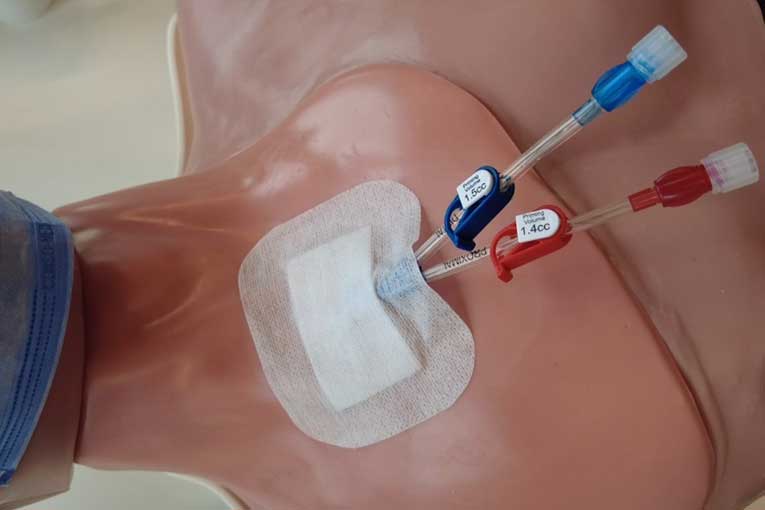- Phone: +91 90020-32757
- info@nefronkidneycare.com
- Mon-Fri (10am - 6pm)


Dialysis Catheter Insertion
A dialysis catheter is a medical device used to provide access to the vascular system for hemodialysis, a procedure used to filter toxins from the blood of people with kidney failure. Dialysis catheter insertion is a procedure performed to provide access to the vascular system for hemodialysis. The procedure is usually performed by an interventional radiologist or vascular surgeon and is done under sterile conditions.
The Dialysis Catheter Insertion Process
The procedure begins with an ultrasound scan of the area where the catheter is to be inserted. This is done to ensure the catheter is placed in the correct spot and to check for any underlying problems that may complicate the procedure. Once the area has been scanned, the patient will be sedated and the insertion site will be cleaned and prepped with an antiseptic.
Next, the catheter is inserted through a small incision in the skin. The catheter is then pushed through the artery and threaded into the right atrium of the heart. Once the catheter is in place, it is secured with sutures or an adhesive patch. The catheter is then connected to a dialysis machine and the procedure is complete.
The insertion of a dialysis catheter is generally considered safe. However, as with any medical procedure there are some risks that include infection, bleeding, or a tear in the artery. Patients should always inform their doctor of any allergies or medical conditions prior to having the procedure.
Overall, dialysis catheter insertion is a relatively safe and common procedure. It is performed to provide access to the vascular system for hemodialysis, a procedure used to filter toxins from the blood of people with kidney failure. The procedure is usually performed by an interventional radiologist or vascular surgeon and is done under sterile conditions. Patients should always inform their doctor of any allergies or medical conditions prior to having the procedure.
The major benefits of Dialysis Catheter Insertion

- 1. Allows for Immediate Access to Dialysis: One of the primary benefits of dialysis catheter insertion is that it allows for immediate access to dialysis. This is especially important for those who have advanced kidney failure, as dialysis may be necessary to support their health. By having the catheter in place, dialysis can begin immediately, without having to wait for the patient to heal from a surgical procedure.
- 2. Reduces Risk of Infection: Another benefit of dialysis catheter insertion is that it reduces the risk of infection. During a surgical procedure, there is a risk of infection due to the incision and other invasive methods. With a dialysis catheter, there is no need to make a large incision, and thus the risk of infection is greatly reduced.
- 3. Minimally Invasive: Dialysis catheter insertion is a minimally invasive procedure, meaning that it requires only a small incision. This is especially beneficial for patients who are elderly or have weakened immune systems, as the risk of complications is reduced.
- 4. Cost-Effective: Dialysis catheter insertion is a cost-effective procedure. It is usually much less expensive than traditional dialysis access procedures, such as a fistula or graft. This makes it a great option for patients who are on a budget or may not be able to afford a more expensive procedure.
- 5. Easier to Manage: Dialysis catheters are generally easier to manage than other forms of dialysis access, such as a fistula or graft. This is because the catheter can be accessed quickly and easily, and there is no need to worry about complicating factors such as clotting or infection.
Overall, dialysis catheter insertion is a safe and effective procedure that provides many benefits to those who need dialysis. It is minimally invasive, cost-effective, and easy to manage, making it an ideal choice for many patients.
What kind of catheter is used for dialysis?
A double-lumen, straight-tip catheter is typically used for dialysis. This type of catheter has two lumens (openings), and one is used for dialysis and the other is used for blood.
What does a dialysis catheter do?
A dialysis catheter is a narrow tube that is surgically inserted into a vein, usually in the neck or chest, and threaded into the patient's heart. It is used to provide a pathway for dialysis treatments to remove waste products and excess fluids from the blood when the kidneys are no longer able to do so.
What is a permanent dialysis catheter?
A permanent dialysis catheter is a long, thin tube that is surgically inserted into a large vein in the chest or neck of a person with end-stage renal disease (ESRD). The catheter is used to access the bloodstream for hemodialysis treatment, a process in which waste products and excess fluid are removed from the body by a dialysis machine. The catheter is usually left in place for many months or even years and is only removed if it becomes blocked or infected.
Where is the dialysis catheter inserted?
A dialysis catheter is inserted into the large veins of the neck, chest, or groin.
Can you shower with a dialysis catheter?
No, it is not recommended to shower with a dialysis catheter. Dialysis catheters are meant to be kept dry, and water exposure can increase the risk of infection.
Can you drink water during dialysis treatment?
Yes, drinking water during dialysis is important to help maintain adequate hydration and to help flush toxins from the body. It is important to drink the recommended amount of fluids as prescribed by the healthcare team.
How do they take out a dialysis catheter?

A dialysis catheter is typically removed by a doctor or nurse under sterile conditions. The procedure is done while the patient is under local anesthesia.
During the procedure, the catheter is pulled gently from the neck, chest, or arm area where it was inserted. The doctor may also use a special tool to close off the opening in the skin where the catheter was inserted.
Do dialysis patients have permanent catheters?No, dialysis patients typically do not have permanent catheters. The catheters are typically temporary and are removed following the dialysis procedure.
When should the dialysis catheter be removed?The dialysis catheter should be removed when it is no longer needed for the patient's dialysis treatment. This can happen when the patient no longer needs dialysis, when the patient has been successfully transitioned to a different form of dialysis, when the patient has been successfully transplanted, or when the catheter is no longer functioning properly.
How long does a dialysis patient live after stopping dialysis?The answer to this question depends on the individual patient and the underlying cause of kidney failure. Generally speaking, if the patient is able to receive alternative treatments that can help preserve kidney function and if the underlying cause of kidney failure can be managed, life expectancy can range from months to years. Without alternative treatments, life expectancy can range from days to weeks.
What are the different types of dialysis catheters?- 1. Percutaneous Catheter: This type of catheter is placed through the skin and into a vein in the neck or chest.
- 2. Tunneled Catheter: This type of catheter is placed under the skin and has a small tube that is used to connect to the dialysis machine.
- 3. Long-term Catheter: This type of catheter is placed under the skin and is designed to stay in place for an extended period of time.
- 4. Implanted Catheter: This type of catheter is placed directly into the heart and is connected to a dialysis machine.
Yes, it is possible to live a full life on dialysis. Many people on dialysis are able to continue their regular activities and live full and productive lives. Dialysis can help people live for many years, depending on their overall health and other individual factors.
Why choose Nefron for Dialysis Catheter Insertion?Nefron provides specialized expertise in the insertion of dialysis catheters, which can be a difficult and complicated procedure. The procedure requires a highly trained and experienced team, and the specialized clinics provide the necessary skills and expertise to ensure the procedure is performed safely and successfully.
Additionally, Nefron as a specialized clinic for Dialysis Catheter Insertion, is equipped with all the necessary tools, supplies, and equipment to complete the procedure. This includes specialized ultrasound machines, sterile equipment, and catheter positioning materials.
Nefron also take extra steps to ensure that all the necessary safety precautions are taken, such as making sure the patient is adequately anesthetized and monitored during the procedure.


